For the Fallen
 In commemoration of Anzac Day, here, by Robert Laurence Binyon (1869-1943), is the well-known poem For the Fallen, which was published in The Times newspaper on September 21, 1914.
In commemoration of Anzac Day, here, by Robert Laurence Binyon (1869-1943), is the well-known poem For the Fallen, which was published in The Times newspaper on September 21, 1914.
Binyon wrote the poem in mid-September, 1914, just a few weeks after the outbreak of WW1, after the British had suffered casualties in their first encounter with the German army at the Battle of Mons. He said it was the words of the famous fourth stanza that came to him first.
Between his timeless words are some photographs I took of a field of poppies in the Rif Mountains of Morocco. (It was a very windy day, and it was hard to capture the dancing poppies, so they’re a bit blurry.)
For the Fallen
With proud thanksgiving, a mother for her children,
England mourns for her dead across the sea.
Flesh of her flesh they were, spirit of her spirit,
Fallen in the cause of the free.
Solemn the drums thrill: Death august and royal
Sings sorrow up into immortal spheres.
There is music in the midst of desolation
And a glory that shines upon our tears.

They went with songs to the battle, they were young,
Straight of limb, true of eye, steady and aglow.
They were staunch to the end against odds uncounted,
They fell with their faces to the foe.
They shall grow not old, as we that are left grow old:
Age shall not weary them, nor the years condemn.
At the going down of the sun and in the morning
We will remember them.
They mingle not with their laughing comrades again;
They sit no more at familiar tables of home;
They have no lot in our labour of the day-time;
They sleep beyond England's foam.
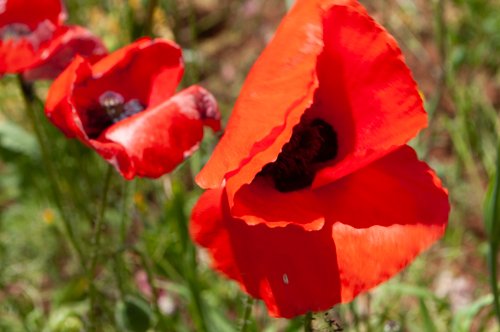 But where our desires are and our hopes profound,
But where our desires are and our hopes profound,
Felt as a well-spring that is hidden from sight,
To the innermost heart of their own land they are known
As the stars are known to the Night;
As the stars that shall be bright when we are dust,
Moving in marches upon the heavenly plain,
As the stars that are starry in the time of our darkness,
To the end, to the end, they remain.
Decoding Thoughts
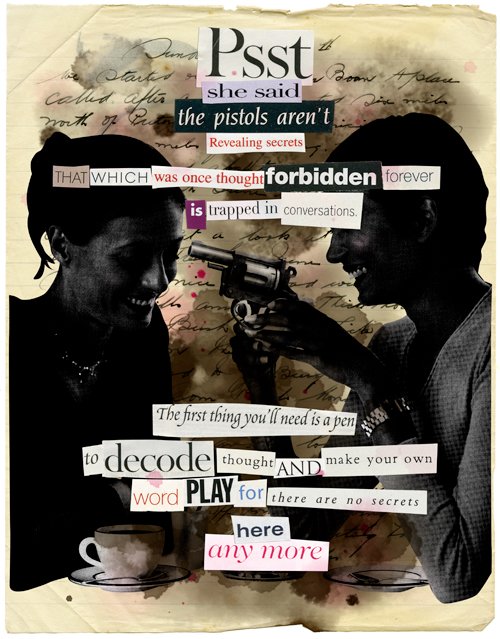 Psst She Said, Helena Turinski 2015Psst she said.
Psst She Said, Helena Turinski 2015Psst she said.
The Pistols aren’t revealing secrets.
That which was once thought forbidden forever is trapped in conversations.
The first thing you’ll need is a pen to decode thought
and make your own word play
for there are no secrets here any more.
I really love assembling my random poems. It’s such an exciting and serendipitous process that evolves rapidly as I snatch up cut-out words that seem to fit whatever I am weaving under my hand. I never know where a poem is going to go either. I haven’t actually ‘written’ any for a while because I have such a huge backlog of poems that I have yet to turn into collages.
The words obviously inform the pictures, but sometimes the pictures themselves add an extraordinary power to one’s perception of the poem, such as in this image. The women were cut out from some innocuous advertisement, although for what I can’t recall. The blackness of the figures adds such a sinister tone, especially with the highlighted white teeth, as does the gun pointed directly at the smiling woman’s head; the metaphors are obvious. The strange and stark contrasts make me chuckle – that’s what society is like sometimes – but we should never ignore the undercurrents.
Layering Dreams
 Always Inside Your Dreams; collage, found paper 240mm (w) x 350mm (h)Last year I took part in a group exhibition called Read What You Look At, at Brunswick Street Gallery in Fitzroy, Melbourne. Funnily, I hadn’t actually planned for it, but had seen a call for applications in the newsletter I receive from the gallery and thought the theme was singularly appropriate for one stream of my fine arts practice.
Always Inside Your Dreams; collage, found paper 240mm (w) x 350mm (h)Last year I took part in a group exhibition called Read What You Look At, at Brunswick Street Gallery in Fitzroy, Melbourne. Funnily, I hadn’t actually planned for it, but had seen a call for applications in the newsletter I receive from the gallery and thought the theme was singularly appropriate for one stream of my fine arts practice.
I have been working on what I call my ‘random poems’ for many years – ever since I finished art college (a frighteningly long time ago) – and they have developed quite a lot over the years. Some of them are traditional hard copy collages, assembled on antique and vintage paper dating from the 1860s–1950s, and others are original digital artworks that combine collage with ink on the same paper backgrounds.
 Labours With Ancient Goddess; original digital artwork; 192mm (w) x 321mm (h)Originally they were all traditional collages, but as I started working with these priceless pieces of crumbling ephemera, I was terrified of ruining or disintegrating them with real ink, so I started experimenting with digital ink. (Some viewers of the exhibition thought it was real ink, so I can plume myself on my success there!) Of course I have to scan everything in, which is a time-consuming although ultimately pleasurable process. But there is still a real charm in the haphazard and inappropriate sizing of the words in the hard copy collages, where conjunctions sometimes shout louder than nouns or adjectives.
Labours With Ancient Goddess; original digital artwork; 192mm (w) x 321mm (h)Originally they were all traditional collages, but as I started working with these priceless pieces of crumbling ephemera, I was terrified of ruining or disintegrating them with real ink, so I started experimenting with digital ink. (Some viewers of the exhibition thought it was real ink, so I can plume myself on my success there!) Of course I have to scan everything in, which is a time-consuming although ultimately pleasurable process. But there is still a real charm in the haphazard and inappropriate sizing of the words in the hard copy collages, where conjunctions sometimes shout louder than nouns or adjectives.
Along the way I also started playing with the effect of turning the cut paper images a stark black and white, for more impact and as a contrast to the coloured letters, and splashes of ink.
Read the original Artist’s Statement on Layering Dreams, or view the gallery.
Hanging Poems
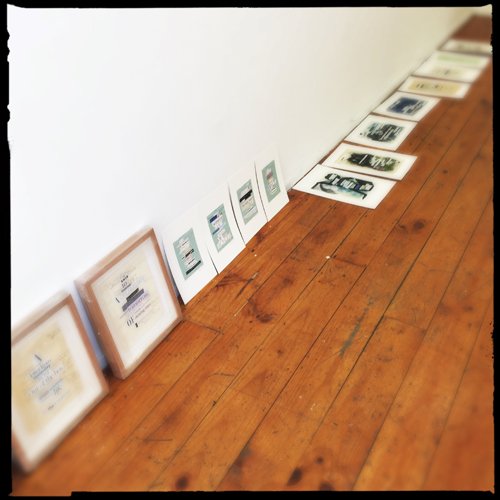 Getting ready to hangLast Thursday night I hung my exhibition at Brunswick Street Gallery. This is only my second group exhibition, and the first time I hung my own work. The method is pretty easy, and it was very satisfying to complete the task. Seeing how many pieces I had (I had originally intended to hang them all in two rows, and was prepared to pull some if it was too crowded) the curator generously allowed me to take up more space than originally allocated, which was fantastic.
Getting ready to hangLast Thursday night I hung my exhibition at Brunswick Street Gallery. This is only my second group exhibition, and the first time I hung my own work. The method is pretty easy, and it was very satisfying to complete the task. Seeing how many pieces I had (I had originally intended to hang them all in two rows, and was prepared to pull some if it was too crowded) the curator generously allowed me to take up more space than originally allocated, which was fantastic.
 Prints pinned
Prints pinned
The works were printed by Karl at Lantern Printing, on cotton rag archival paper using archival pigment inks. They came up beautifully, and the crumpled antique papers look so realistic and three-dimensional. Two originals were float-mounted in oak frames, by Leigh at Auguste Clown Gallery.
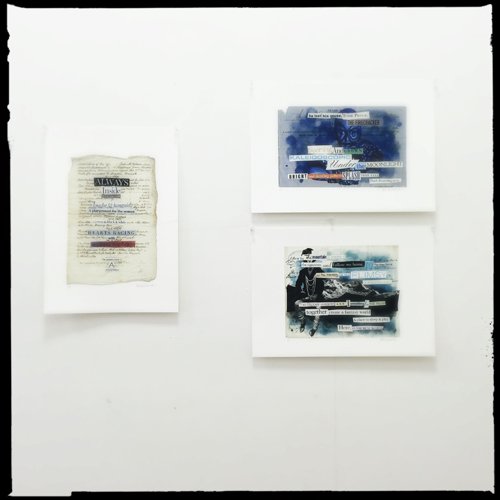 Works on exhibit include prints of hard copy originals, and prints of entirely digital artworks Opening night was on Friday, and unfortunately I was far too busy talking to guests to remember to take any photos – tsk! It was a fun evening, despite a few nerves at the start. I was hoping to overhear viewers’ responses, but alas, again, too busy talking to eavesdrop!
Works on exhibit include prints of hard copy originals, and prints of entirely digital artworks Opening night was on Friday, and unfortunately I was far too busy talking to guests to remember to take any photos – tsk! It was a fun evening, despite a few nerves at the start. I was hoping to overhear viewers’ responses, but alas, again, too busy talking to eavesdrop!
 Frames hung (not without errors prior to success!)At the conclusion of the show (two weeks from now), I will create an online gallery here for viewing. Most of the pieces on show are prints of traditional (hard copy) collages, but you can check out my digital pieces in the Random Poetry galleries.
Frames hung (not without errors prior to success!)At the conclusion of the show (two weeks from now), I will create an online gallery here for viewing. Most of the pieces on show are prints of traditional (hard copy) collages, but you can check out my digital pieces in the Random Poetry galleries.
 The works are printed on cotton rag archival paper
The works are printed on cotton rag archival paper
Layering Dreams
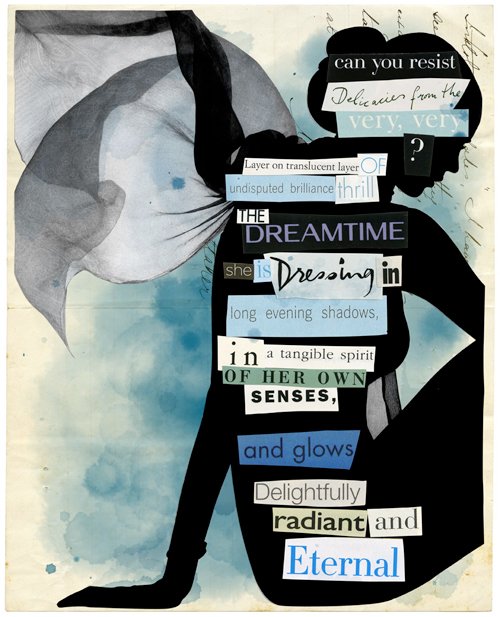 I am excited to share the news that I am taking part in a group exhibition at Brunswick Street Gallery called Read What You Look At, which opens this Friday night, and runs for two weeks.
I am excited to share the news that I am taking part in a group exhibition at Brunswick Street Gallery called Read What You Look At, which opens this Friday night, and runs for two weeks.
Although it is not my first group exhibition, it is the biggest one I’m showing in, with fourteen pieces of my ‘random poetry’ mixed-media collages on view. The series is entitled Layering Dreams, and is – you guessed it – all about dreams, sleeping, and waking.
Here is an abridged version of my artist’s statement:
From a very young age, I was captivated with telling stories through both words and pictures, often drawing and writing on found paper. At art college after studying the Dadaists, I became interested in writing poetry by reassembling random words. Recycling my magazine collection, I created a pool from which I could pull words to compile into ‘random poems’.
Always interested in dreams, and the surrealism intertwined with hidden meanings, this method of writing poetry appealed to me. Naturally, I choose words that I find appealing, but sometimes I deliberately choose ones that I don’t. This strange combination contributes to the elusive mood of Layering Dreams, often with unexpected results.
 Sometimes a poem just starts with two or three words, and I slowly build on those. The poems are engaging and easy to read not only because of their brevity, but because of how they look. The fonts and colours culled from so many different sources interact with one another visually, encouraging the viewer to also ‘look at what they read’.
Sometimes a poem just starts with two or three words, and I slowly build on those. The poems are engaging and easy to read not only because of their brevity, but because of how they look. The fonts and colours culled from so many different sources interact with one another visually, encouraging the viewer to also ‘look at what they read’.
Returning to my roots of acquiring used paper (I’d pinch my sisters’ papers from their school folders!), I’ve sourced antique papers from the late nineteenth century to the 1950s, to use as supports for the collages. As well as traditional (hard copy) collages using only words, I also create digital works, combining scanned words and images cut from magazines with digital ink.
These many layers of ephemera, words, and pictures combine to evoke the otherworldly nature of dreams.
If you happen to be in Melbourne, I’d love for you to come and check them out in person!


